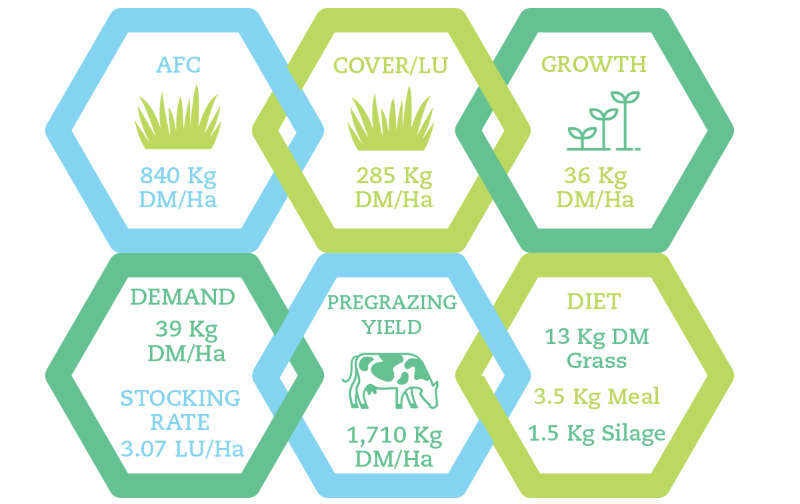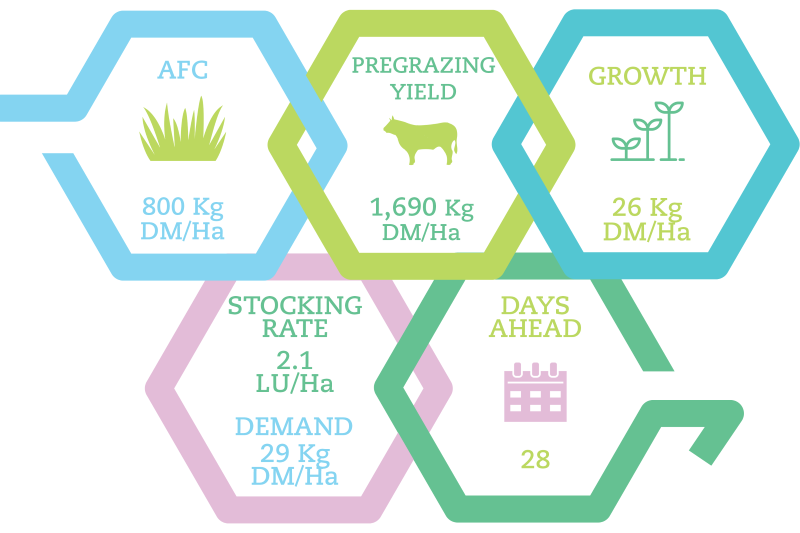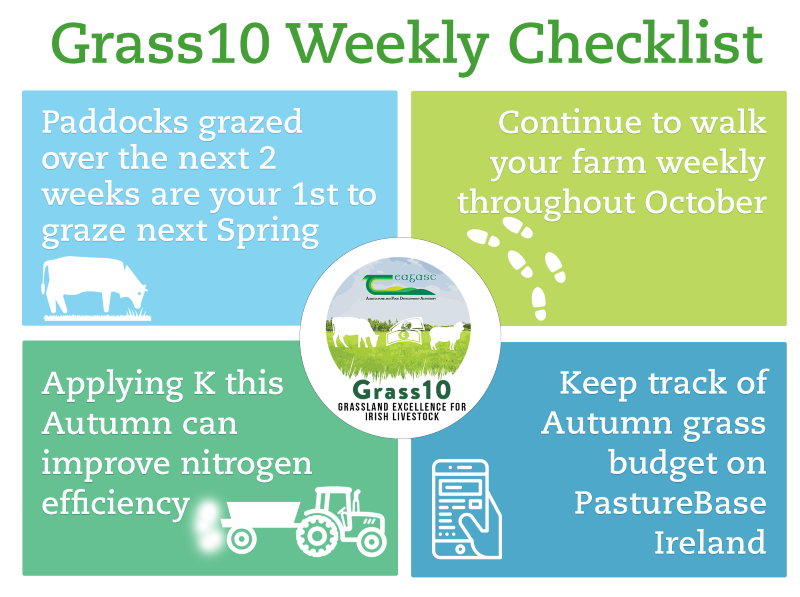19 October 2022
Grass10 Newsletter 18th October

In this week’s Grass10 newsletter, get updates from PastureBase Ireland on predicted grass growth and rainfall. Get information on the grass situation for PastureBase dairy and drystock farmers. Get other advice and updates from the Grass10 team.
PastureBase Ireland – Dairy Figures

- Average Farm Cover – 840 Kg DM/Ha
- Cover/LU – 285 Kg DM/Ha
- Growth – 36 Kg DM/Ha
- Demand 39 Kg DM/Ha – Stocking rate 3.07 LU/Ha
- Pregrazing yield – 1,710 Kg DM/Ha
- Diet – 13 Kg DM Grass – 3.5 Kg Meal – 1.5 Kg Silage
Predicted Grass Growth
 Counties map showing predicted grass growth over the next 7 days from farms involved in Elodie Ruelle’s MoSt grass growth model on 78 farms.
Counties map showing predicted grass growth over the next 7 days from farms involved in Elodie Ruelle’s MoSt grass growth model on 78 farms.
Growth rates vary across the country ranging from a low 16 in Roscommon to highs of 30 in Wexford.
Predicted rainfall

Counties map showing predicted rainfall in mm for the next 7 days from farms involved in Elodie Ruelle’s MoSt grass growth model – 78 farms.
Rainfall is predicted to have a high of 61mm in Waterford to lows in Sligo of 26mm.
Grass Dry Matter %

- Moorepark 14%
- Athenry 14%
Grass 10 Weekly Tips
- Paddocks grazed over the next 2 weeks are your 1st paddocks to graze in Spring
- Continue to walk your farm weekly throughout October
- Applying K this autumn can improve nitrogen efficiency
- Keep track of Autum Grass Budget on PastureBase Ireland
Paddocks grazed over the next 2 weeks are your 1st paddocks to graze in Spring
Between now and the end of October you should be grazing and closing paddocks that are key to getting grazing started next Spring. The paddocks we want to graze first in the spring should be the easiest ones to get stock out to from the yard, drier, good access, roadways on 2 sides, recently reseeded for quicker growing and the cover should be 700-1100 kg DM/Ha in February. Grazing lighter covers means they are easier to graze out, and grazing more area to reach 30% grazed by March 1st. Stock are less likely to do damage and these paddocks should recover quickest to start the 2nd rotation on time. Paddocks closed up early in the autumn will be too heavy for freshly calved cows or cattle who need to adjust back to grazing. Ensure the paddocks you want to graze first in the spring are grazed from October 20th until early November.
The aim on dry farms is to have 60-70% of the farm closed by 1st November and heavy soils over 80%. Some higher stocked farms will have closer to 80% closed in October too. So for a 30ha farm this means grazing 20ha (66%) in 25 days, i.e. 0.80ha/day or 5.5ha per week. With challenging weather conditions forecasted, on-off grazing and 12 hour wires will be more appropriate over the coming week.
Continue to walk your farm weekly throughout October
With increased costs of inputs predicted for 2023, we estimate grazing early next spring to be worth €4 per cow/day on dairy farms and between €2.50 and €3 per LU on beef and sheep farms. It is vital especially for farms with large spring demand to close the farm correctly, ensuring a wedge of grass that can grow over the winter is prioritised. Mistakes we often see is farmers who take advantage of the good grazing conditions and don’t house animals in time, eating into their AFC and therefore severely hampering over winter growth and opening farm cover in early 2023. The key to this is to continue to walk your farm weekly and keep an eye on growth vs demand, especially during late October.
Applying K this autumn can improve nitrogen efficiency
Recent research from Johnstown Castle confirms that now is the best time to apply extra potassium to build soil K levels. Check soil test results and identify which fields (Index 1 or 2) that require additional K and build soil K fertility to the optimum Index 3. An autumn application of K resulted in highest chemical N efficiency in the following spring compared to spring applied K. In addition, applying K at this time of the year reduces issues with potential grass tetany in grazing animals next spring and reduces luxury K uptake in grass silage swards.
Each 1 ton grass DM/ha removes ~25kg K/ha (20 units K /ac). For example two cuts of grass can remove in the region of 200 to 250kg/ha (160 to 200 units/ac) depending on grass yield (8 to 9t DM/ha or 16 to 18 t fresh grass/ac). Now is a good time to work out crop K offtakes especially for intensively cut grass silage fields and ensure sufficient K return to maintain soil fertility levels.
There is no restriction of the application of K fertilisers as we have with both N and P fertilisers. Potassium is supplied by muriate of potash fertiliser (MOP 50% K). Adjust fertiliser K rates for cattle slurry applied for example good quality cattle slurry (6%DM) contains ~29 – 32 units K /1,000 gals. Muriate of potash (MOP 50% K) can be applied at any time of the year and is an effective way to build soil K levels rapidly. Aim to apply recommended K build up rates as shown in table 1 below.
Table 1: Recommended POtassium Build-Up Rates in Kg/ha
| Soil K Index | K kg/ha – units/ac | Suggested Fertiliser Programme |
|---|---|---|
| 1 | 60 – 48 | 129kg/ha MOP 50%K – 1 bag per acre |
| 2 | 30 – 25 | 60kg/ha MOP 50% – 0.5 bag per acre |
Keep track of Autum Grass Budget on PastureBase Ireland
Farm cover has began its downward trajectory as growth starts to decrease while demand stays constant on many farms. The shorter days and increased rainfall will result in poorer growing conditions over the next week. Grass growth will be variable with weather conditions, with predictions ranging from 16-30 KgDM/ha/day depending on weather. The grass budget on PBI will help make the most of this grass, mapping out your grazing until housing. Stretching out grass will increase the amount grown and every day at grass increases profitability of your farm. Target AFC for 1st December range from 600-750 KgDM/ha for most farms with higher stocking rates on drier farms requiring a higher closing cover. The budget will also indicate how much silage will need to be fed before the winter starts, this is crucial to allow farmers to take action if fodder deficits exist.

Grass10 Featured Farmer
 Sean O Donnell, Co. Mayo
Sean O Donnell, Co. Mayo
Sean O’Donnell farms near Ballina, Co. Mayo. Sean milks 215 cows across two grazing platforms. Sean was 2021 Mixed Soils Grassland Farmer of the Year Winner. Excellent grazing conditions in the West have left autumn management easier for Sean. He has 45% closed on his platforms so far. Continue reading below
Read Seans’s full grazing update here
PastureBase Ireland – Drystock Figures

- Average Farm Cover – 800 Kg DM/Ha
- Pregrazing yield – 1,690 Kg DM/Ha
- Growth – 26 Kg DM/Ha
- Stocking rate – 2.1 LU/Ha
- Demand – 29Kg DM/Ha
- Days ahead – 28
The Clover Reporter

Jim White, Co. Tipperary
This section gives weekly reports and videos from farmers who have a lot of clover established on their farms.
This week,we return to Dairy farmer Jim White from Co. Tipperary who updates us on autumn nutrient management for his grass – clover swards and a sample of what some of his grass – clover swards have grown year to date.
Location: Clonmel, Co. Tipperary
Enterprise: Dairy
Soil Type: Dry soils
2021 Data
% Farm In Clover: 32% (21.4ha)
% From Reseeding: 49% (10.4ha)
% From Oversowing: 51% (22ha)
Clover content 2021: 18% on 21.4ha
Read Jim’s full clover report here
Grazing Management to prevent bloat
Bloat can be an issue in swards with high white clover content. Bloat can occur at any time of the year but it is more likely to occur in the second half of the year when white clover content in the sward is highest. Good grassland management can minimise and prevent the risk of bloat
- Avoid switching between grass-only and grass-white clover swards, as much as is possible
- Avoid having cows hungry entering a fresh paddock. Keep post-grazing sward height at or just above 4 cm, not below. This will ensure that cows are fed to appetite and will be consuming a mixture of grass and clover. They will not be hungry when they move to a fresh paddock/break and therefore will not have a large intake of clover in a short period of time.
- When entering a grass-white clover paddock in risky conditions – high white clover content / hungry animals / wet morning / very lush pasture) provide a small area in the paddock for the first 2-3 hours after turn-out to prevent the initial gorging on white clover.
- Provide anti-bloating agent in the water supply – starting the day prior to entering the risky paddock.
- Offer a fibre source such as silage, hay or straw at milking time for example i.e. 0.5 – 1 kg DM per cow.
- Check cows after initial turnout and regularly for first three hours of grazing during high risk periods




